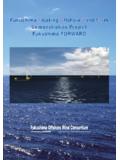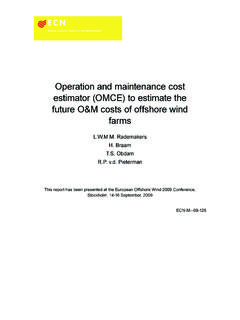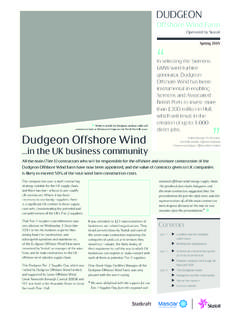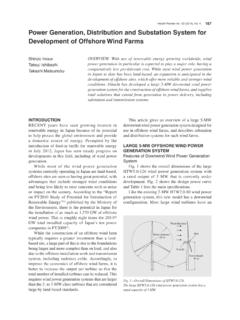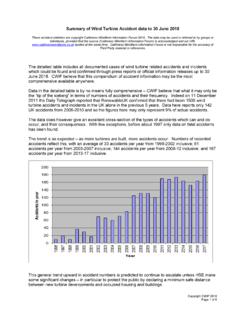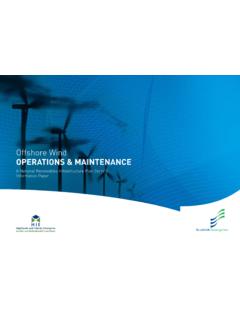Transcription of Wind Energy (SRO20) - Health and Safety Executive
1 February 2009 HORIZON SCANNING SR020 HSE Horizon Scanning wind Energy Issue The Health and Safety implications of the increasing use of wind Energy in the UK. Status: Active monitoring Background wind Energy can be described as the harnessing of moving air by wind turbines to produce electricity. The UK has the best wind resource in Europe1 and has excellent prospects for wind Energy with offshore wind power having the potential to provide a third of the UK s current demand for electricity in the short to medium term (the accessible offshore wind resource is estimated to be many times the UK demand.)
2 However this estimate only accounts for water depth, not other constraints).2 Electricity Generated by wind Power8 Onshore Offshore 4,000 3,500 3,000 2,500 2,000 1,500 1,000 500 - wind power use has been increasing rapidly in the UK over recent years (see above) and appears to be starting to enter an enormous growth phase. This year the UK will become world s largest generator of offshore wind The increase has been driven primarily by the Government s Renewables Obligation (requiring licensed electricity suppliers to source an annually increasing percentage of the electricity they supply from renewable sources4).
3 The current level is for 2008/09 rising to by 2015/16. As well as an EU target for the UK to generate 15% of Energy from renewables by 20205. The British wind Energy Association (BWEA) predicts that by then up to 40% of the UK s electricity will be from wind 1 2 3 4 6 GWh 1998 1999 2000 2001 2002 2003 2004 2005 2006 This document is produced for horizon scanning purposes and gives only a brief guide to the topic. Where the topic is already receiving attention in HSE there will be links to other relevant pages. Given the nature of horizon scanning activity, Horizon Scanning Short Reports do not necessarily reflect HSE policy or guidance. The Renewable Energy Strategy (RES) unveiled on June 26, 2008 by the Prime Minister commits the UK to meeting the 15% target of the UK's Energy to come from renewable sources by 2020.
4 A large proportion of those renewables will have come from wind , and a government study has estimated this to be around 33-35GW of capacity (up from currently), delivering over 60 billion of investment and potentially creating up to 160,000 new green collar jobs in the renewables industry as a The Prime Minister Gordon Brown stated that: The North Sea will be transformed into the global centre of the offshore wind industry. Government plans state an extra 4000 onshore and 3000 offshore turbines will be required as part of a 100bn investment in renewable This investment is proposed to come from the private sector, encouraged by financial incentives from the Almost 7GW of wind Energy schemes are in construction or already approved, along with others at various stage of development giving a total of 19GW of Future estimates by the wind Energy industry show that by 2013 wind capacity will be over (overtaking nuclear)
5 , increasing to 6GW offshore alone by 2015 and up to 20GW offshore by The world s largest offshore wind farm consisting of 271 turbines is to be built in the Thames estuary; it is hoped the first phase will be completed by Developments in wind turbine design are allowing the production of ever-larger wind turbines up from an average of 3MW to planned offshore designs and maybe Other wind -powered designs include kites. A recent development at Delft University used a large kite attached to a generator to generate enough power for 10 houses (10kW). Scientists will soon test a 50kW version. They ultimately aim to build a multiple kite version to take advantage of the jet stream (which flows over the UK), producing potentially enough power for 100,000 homes.
6 Other groups in the US and Italy are working on similar Additionally there are a large number of small and micro- wind turbines in the UK, either free standing or on buildings. In 2006 BERR launched their Microgeneration Strategy and this has led to a number of initiatives in the UK, such as fitting these on schools and There is also a significant manufacturing base for these smaller turbines in the UK (whereas nearly all large turbines are made overseas). Potential problems that may slow developments14 include: -Hold-ups in the planning process or long delays in getting connection to the National Grid15. -The National Grid network is old and will require upgrading to allow for the speedy connection of new wind farms, although moves to do this are expected to be announced of supply ( wind turbines are only active 70-85% of the time according to BWEA).
7 16 This may require the use of novel Energy storing systems or development of a smart grid (a grid able to take power from multiple sources and distribute it according to demand).17 7 8 9 11 12 13 14 15 16 17 Comments are welcome on all horizon scanning reports using the Getting Involved web page -Other issues currently holding up wind farm applications are concerns from the public, aviation, MOD (potential effects on radar) other users of the sea (ships etc) and concerns about impacts on wildlife)18 What is HSE doing? The hazards in this industry include working from height, slips and trips, contact with moving machinery, possible risks of electrocution or from fire and construction in very windy conditions.
8 Offshore construction is even more hazardous including risks from large waves, diving activities, siting the turbines and issues such as stepping from a boat onto a turbine. wind turbines also require regular maintenance; therefore workers will be exposed to these risks regularly. Although it is a rare occurrence, wind turbine blades have failed19 and these or fragments have been shown to travel over appreciable distances; blades can also throw ice. Additionally, structural failures can occur (HSE investigated two turbine collapses late in 2007)20 and turbines are prone to being struck by lightning, which could cause damage and fire. BWEA published guidelines on Health and Safety (H&S) for the wind Energy industry (April 2005) in association with HSE and various industry stakeholders and it holds yearly H&S seminars: additionally it records data on accidents and near Data is also collected by HSE via RIDDOR (Reporting of Injuries, Diseases and Dangerous Occurrences Regulations) and ESQCR (Electricity Safety , Quality and Continuity Regulations 2002).
9 HSE s Expert Report for the Government s Energy Review 2006 states that current Health and Safety law is generally adequate to cover the risks associated with wind power. The main need is for more attention to safe design and integrity and (onshore) closer scrutiny at land use planning Indeed, HSE is at the early stages of modifying an existing model23 for wind turbine throw, using data from the BWEA, which could be used as a tool for companies making planning proposals. HSE s Utilities section is also involved in a range of issues including safe access to turbines, public Safety concerns, supply chain issues and skills and labour issues (non-UK nationals working for foreign manufacturers or supplier companies at wind farms; potential language, different standards issues) and other offshore specific concerns.
10 Recommendations Given the large expansion planned in wind turbine construction it can be expected that the potential for accidents will increase and that some of these will involve workers and the public. -HSE needs to consider the resource implications of inspecting and regulating for this large increase. -HSE to consider whether to put more resource into looking at the small/micro end of wind generation (within its responsibilities), which is increasing in the UK. An accident in this sector could have reputational damage on the whole wind sector. -HSE to work with other agencies, countries and wind turbine suppliers on the safe design and integrity of wind turbines.










